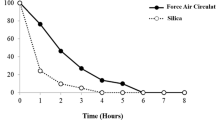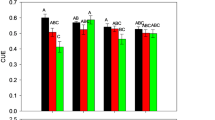Abstract
Eco-physiological and plant performance responses and acclimation of Populus euphratica Oliv. to water release of the lower reaches of Tarim River, China were investigated. Three representative areas and 15 transects were selected along the lower reaches of the Tarim River. The groundwater level and salt content as well as plant performance and the contents of proline, soluble sugar, and plant endogenous hormone (ABA, CTK) in leaves were monitored and analyzed before- and after-water release. The groundwater level was raised in different areas and transects by the water release program. The physiological stress to P. euphratica decreased after the water release. Our results suggested that the groundwater level in the studied region changed from −3.15 to −4.12 m, salt content of the groundwater from 67.15 to 72.65 mM, the proline content from 9.28 to 11.06 mM, the soluble sugar content from 224.71 to 252.16 mM, the ABA content from 3.59 to 5.01 ng/(g FW), and the CK content from 4.01 to 4.56 ng/(g FW)- for the optimum growth and recover of P. euphratica indicated by the plant performance parameters, and the efficiency of water release was the highest.




Similar content being viewed by others
References
Aguilar ML, Espadas FL, Coello J, Maust BE, Trejo C, Robert ML, Santamaria JM, (2000) The role of abscisic acid in controlling leaf water loss, survival and growth of micropropagated Tagetes erecta plants when transferred directly to the field. J Exp Bot 51:1861–1866
Aspinall D, Paleg LG (1981) Proline accumulation: physiological aspects. In: Paleg LG, Aspinall D (eds) The physiology and biochemistry of drought resistance in plants. Academic, Sidney pp 215–228
Bano A, Dorffling K, Bettin D, Hahn H (1993) Abscisic acid and cytokinins as possible root-to-shoot signals in xylem sap of rice plants in drying soil. Aust J Physiol 20:109–115
Boggess SF, Stewart CR, Aspinall D, Paleg LG (1976) Effect of water stress on proline synthesis from radioactive precursors. Plant Physiol 58:398–401
Bohnert HJ, Nelson DE, Jensen RG (1995) Adaptations to environmental stresses. Plant Cell 7:1099–1111
Campalans A, Messeguer R, Goday A, Pages M (1999) Plant responses to drought, from ABA signal transduction events to the action of the induced proteins. Plant Physiol Biochem 37(5):327–340
Chen YN, Zhang XL, Cui WC (2003) Ecological problems and proposals in Tarim River Basin, Xinjiang (in Chinese). J Chin Acad Sci 3:191–195
Chen YN, Zhang HF, Li WH, Chen YP (2005) Study on species diversity and changes of groundwater level in the lowers reaches of Tarim River, Xinjiang, China (in Chinese). Adv Earth Sci 20(2):158–165
Crowe JH, Hoekstra FA, Crowe LM (1992) Anhydrobiosis. Ann Rev Physiol 54:579–599
Cushman JC (2001) Osmoregulation in plants: implications for agriculture. Am Zool 41:758–769
Dungey NO, Davies DD (1982) Protein turnover in isolated barley leaf segments and the effect of stress. J Exp Bot 33:12–20
Guerrier G, Patolia JS (1989) Comparative salt responses of excised cotyledons and seedlings of pea to various osmotic and ionic stresses. J Plant Physiol 135:330–337
Gzik A (1996) Accumulation of protein and pattern of α-amino acids in sugar beet plants in response to osmotic, water and salt stress. Environ Exp Bot 36(1):29–38
Incoll ID, Roy JP, Jewer PC (1990) Do cytokinins act as root to shoot signals. In: Itai C, Vaadia Y, 1965. Kinetin like activity in root exudate of water stressed sunflower plants. Physiol Plant 18:941–944
Ingram J, Bartels D (1996) The molecular basis of dehydration tolerance in plants. Annu Rev Plant Physiol Plant Mol Biol 47:377–403
Mattioni C, Lacerenza NG, Troccoli AD, Leonardis AM, Di Fonzo N (1997) Water and salt stress-induced alterations in proline metabolism of Triticum durum seedlings. Physiol Plant 101:787–792
Masia A, Pitacco BL, Giulivo C (1994) Hormonal responses to partial drying of the root system of Helianthus annuus. J Exp Bot 45:69–76
Pillay I, Beyl C (1990) Early responses of drought-resistant and–susceptible tomato plants subjected to water stress. Plant Growth Regul 9:213–220
Ragab R, Prudhomme C (2002) Climate change and water resources management in arid and semi-arid regions: prospective and challenges for the 21st century. Biosyst Eng 81(1):3–34
Rayapati PJ, Stewart CR (1991) Solubilization of a prolin dehydrogenase from maize (Zea mays) mitochondria. Plant Physiol 95:787–791
Rekika D, Nachit MM, Araus JL, Monneveux P (1998) Effects of water dificit on photosynthetic rate and osmotic adjustment in tetraploid wheats. Photosynthetica 35:129–138
Sanchez FJ, Manzanares M, Andre EF, Tenorio JL, Ayerbe L (1998) Turgor maintenance, osmotic adjustment and soluble sugar and proline accumulation in 49 pea cultivars in response to water stress. Field Crops Res 59:225–235
Shevyakova NY (1983) Metabolism and physiological role of proline in plants under conditions of water and salt stress. Sov Plant Physiol 30:587–608
Strauss G, Hauser H (1986) Stabilization of lipid bilayer vesicles by sucrose during freezing. Proc Natl Acad Sci USA 83:2422–2426
Troll W, Lindsley J (1955) A photometric method for the determination of prolin. J Biol Chem 215:655–660
Vonk CR, Davelaar E, Ribot SA (1986) The role of cytokinins in relation to flower-bud blasting in Iris cv. Ideal: cytokinin determination by an improved enzyme-linked immunosorbent assay. Plant Growth Regul 4:65–74
Yang JP (2002) Study on the ecological construction problem in Tarim River valley (in Chinese). For Econ 2:1–10
Zhang LY, Xia L (1997) The vegetation and its utilization in the southern fringe of the Taklimakan Desert (in Chinese). Arid Zone Res 14(3):16–22
Acknowledgments
The authors are grateful to NBRPC (National Basic Research Program of China no: 2004CB720201), NSFC (National Natural Science Foundation of China no: 30470330) for the financial support of the work.
Author information
Authors and Affiliations
Corresponding author
Rights and permissions
About this article
Cite this article
Wang, Q., Ruan, X., Chen, Y.N. et al. Eco-physiological response of Populus euphratica Oliv. to water release of the lower reaches of the Tarim River, China. Environ Geol 53, 349–357 (2007). https://doi.org/10.1007/s00254-007-0650-9
Received:
Accepted:
Published:
Issue Date:
DOI: https://doi.org/10.1007/s00254-007-0650-9




